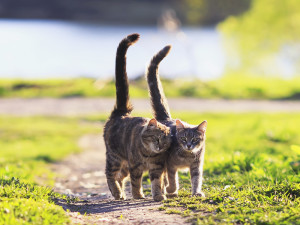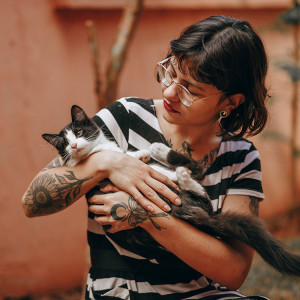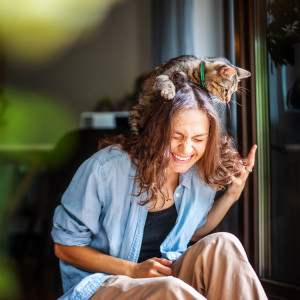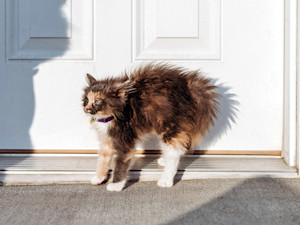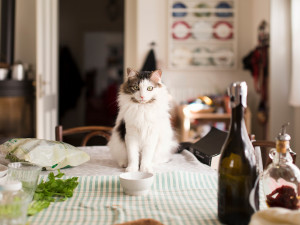Why Do Cats’ Tails Puff Up?
Find out what that’s all about.
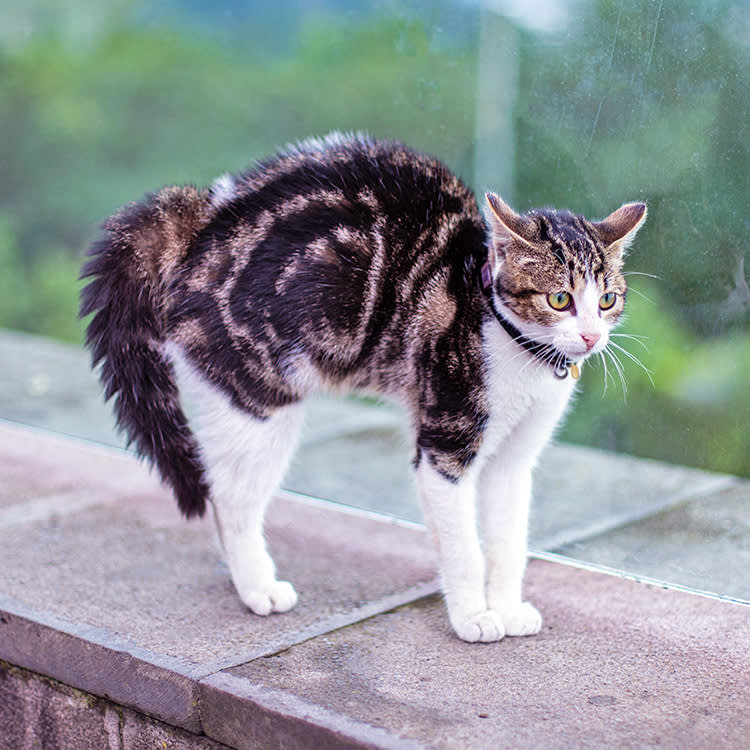
Share Article
In This Article:
What Causes a Cat’s Tail to Puff Up? How to Respond When Your Cat’s Tail Puffs Up Frequently Asked Questions
Your cat has all kinds of ways of telling you how they’re feeling. If they flatten their ears out to the side and squint their eyes, they are probably annoyed. If there eyes are big and round, they’re probably scared. Rolling around on their back, paws ready to swat? It’s playtime.
But what about when they walk by, tail puffed as much as a feather duster? That seems a little ominous... let’s get into it.

What causes a cat’s tail to puff up?
Think of the stereotypical Halloween cat image, with the arched back and spiky fur. That spiky fur is called piloerection. It simply means that a cat’s fur is standing up.
You might hear it referred to as “raising their hackles.” They do this using the muscles that those individual hairs are attached to. It’s the same idea as the hair on your arm or the back of your neck standing on end when you get a chill or a spooky feeling.
You may be surprised to learn that piloerection is involuntary. Cats don’t have to make a decision to puff up. It’s an instinctive response to stimuli, which we’ll discuss more in a moment.
They also don’t have to puff up all their fur. Different areas of the body can exhibit piloerection, while the rest of the fur stays smooth. The tail is a common puffing-up zone and an important tool for communication. Piloerection also isn’t unique to cats. Dogs and other mammals, including humans, experience this unique response.
But why is your cat puffing that tail up?
Aggression or defense
One of the reasons cats puff their tails is to appear larger and more intimidating to potential foes, whether it’s a stranger cat, predator, or even a person they’re afraid of.
Given the option, they’d prefer not to fight because they risk injury themselves. Instead, they give big, intense warning signs in hopes of scaring off their adversary before anyone gets hurt, like puffing their tail.
Fear or survival instinct
Most aggression in cats is a response to fear. They may be afraid of another animal or person, worried for their safety or resources, or find themselves in a scary situation. That defensive response to fear often leads to a puffed-up tail, along with other instinctual behaviors, like hissing, growling, or lunging.
Surprise or startle response
A surprised cat will often puff up in the moment they’re startled. You’ll see it when one cat jumps out from around the corner to pounce on another, or you drop something in the kitchen that makes a loud sound. It’s an instinctual response when they don’t know exactly what happened, but their body says, “let’s get bigger just in case we need to scare something off.”
Playful behavior
Cats will puff up their tails during play. You see it more with kittens, but adults do it, too.
One of the reasons cats play is to flex their hunting and defensive muscles. It’s good practice, and it’s fun. It makes sense that a cat in a playful “fight to the death” with their favorite toy might display that same instinctual piloerection that they would during a real fight.
There are also lots of sudden movements and stealth attacks if they’re playing with another animal or person, which can lead to a startled puff up. It’s common (and adorable) to see them puff the tail and do the sideways hop during play, as if they’re the scariest six-pound predator ever.
This kind of puffed tail is all in good fun.
Environmental changes
Various things in a cat’s environment can cause their tails to puff up. Think about what might trigger the feelings or situations we’ve been discussing. If there are things in the environment that have your cat nervous, fearful, defensive, or surprised, the fur on their tail may stand up.
Piloerection can also play a role in temperature regulation by trapping a layer of air close to the skin as insulation. A cat may puff up when they’re cold. Cats can even puff their tail if they’re feeling physical pain or discomfort. Something like skin allergies could trigger the hair on the tail to stand on end when it’s bothersome.
How to respond when your cat’s tail puffs up
If your cat’s tail gets puffy, take a moment to assess the situation.
Are you seeing other body language that suggests your cat is having a negative experience, like airplane ears, hissing, cowering, swatting, etc.? Or are you in the middle of an epic game of hide-and-seek that they’re clearly enjoying? Is there anything happening in the environment that could be triggering, like the air conditioner kicking on or a neighborhood cat showing up outside the window?
These clues will help determine whether your cat is having a potentially stressful, negative reaction to something. If so, you can look for ways to turn the intensity down for your cat safely. For example, if something startled them, you can offer some soft praise or toss a few treats to help them relax. If an outside cat is causing stress, you can politely ask that cat to leave or block your cat’s view.
Just use caution. A fearful or stressed cat may get aggressive even if you’re trying to help. Giving them some space is a good idea.
Bottom line
Many animals, including humans, can stand their hair on end. This is called piloerection. Cats often do this with their tails when they’re exposed to stimuli that might startle them or spark their defensive instincts.
It’s usually meant to make them look larger and more intimidating, in an effort to scare off potential foes and avoid a fight. If your cat is puffing up their tail and seems distressed, they may need your help to remove whatever’s triggering them so they can let their guard down.
FAQs
Is a puffed-up tail always a sign of fear in cats?
A puffed tail is not necessarily a sign of fear. Cats get puffy (piloerection) for many reasons, like being surprised, feeling the need to defend themselves, and even to warm up.
Can a cat’s tail puff up due to excitement or playfulness?
A cat’s tail can absolutely get puffy when they’re excited and playful. Play is full of surprises that can lead to a tail-puff, as can playfully practicing their defensive moves.
How should I react if I see my cat’s tail puffing up?
While puffing their tail is a completely natural behavior, it can be a sign that something is causing your cat distress, in which case you should look for potential triggers and try to safely help your cat relax.
Are certain cat breeds more prone to having their tails puff up?
Some breeds may puff their tails more than others. But it’s really more about the environment and the cat’s personality. A skittish cat may experience piloerection more often than a super confident cat. If there’s a lot of noise in the home, you may get more puffy tails. A playful kitten practicing their hunting and defensive skills will get puffed up more than a mellow adult might.

LeeAnna Buis, CFTBS, FFCP
LeeAnna Buis has adored cats her entire life and thought she knew them inside out and sideways. But it wasn’t until she worked with a feline behavior consultant that she fully understood how incredible, complicated, and inspiring they really are. She made a career change, starting the certification process to become a behavior consultant right away. She discovered what unique, fascinating, complex creatures cats are and knew this was what she wanted to do with her life — help others on a similar journey to truly knowing, loving, and appreciating their cats.
LeeAnna earned her certification through Animal Behavior Institute, where she received the certified feline training and behavior specialist (CFTBS) designation.
Related articles
![Two cats walking with their tails sticking straight up]()
Cat Tail Meanings
Cats are enigmas. But their tail movements can reveal a lot about their moods.
![Tattooed and pierced woman wearing a black and white striped shirt and holding an upset looking cat]()
Is My Cat Angry at Me? How to Tell if Your Cat is Upset
Cat behaviorist Kristiina Wilson on how to tell if your cat is grumpy—or just kind of like that.
![]()
How to Read Your Cat’s Poker Face
A guide to their not-so-secret tells.
Why Is My Cat Suddenly Clingy?
They’re never far away, but you’d like a little distance.
![Cute scared kitten outside by the front door.]()
7 Surprising Things Cats Are Afraid Of
The term “scaredy-cat” didn’t enter the lexicon out of nowhere.
![cat staring at person on table]()
Why Does My Cat Stare at Me?
...Is it something you said?


